Human emerging respiratory pathogens bulletin: Issue 88, April 2024
Download in PDF format
(588 KB, 4 pages)
Organization: Public Health Agency of Canada
Published: 2024-05-14
Cat.: HP38-6E-PDF
ISBN: 2563-9420
Pub.: 230012
Monthly situational analysis of emerging respiratory diseases affecting humans (data to April 30, 2024).
In this bulletin
- Avian influenza updates
- Swine influenza updates
- Middle East respiratory syndrome coronavirus (MERS-CoV) update
| Novel influenzaFootnote 1 | Cumulative Case CountFootnote 2 | Deaths | Case Fatality Rate %Footnote 3 | Date of Last ReportFootnote 4 |
|---|---|---|---|---|
| Avian Influenza | ||||
| A(H1N2)Footnote 5 | 2 | 0 | 0% | January 2019 |
| A(H3N8) | 3 | 1 | 33% | March 2023 |
| A(H5N1) | 907 | 469 | 52% | April 2024 |
| A(H5N6) | 90 | 35 | 39% | January 2024 |
| A(H5N8) | 7 | 0 | 0% | February 2021 |
| A(H7N4) | 1 | 0 | 0% | February 2018 |
| A(H7N9) | 1,568 | 615 | 39% | April 2019 |
| A(H9N2) | 128 | 2 | 2% | April 2024 |
| A(H10N3) | 3 | 0 | 0% | April 2024 |
| A(H10N5) | 1 | 1 | 100% | January 2024 |
| Swine Influenza | ||||
| A(H1N1)v | 48 | 1 | 2% | February 2024 |
| A(H1N2)v | 52 | 0 | 0% | March 2024 |
| A(H3NX)vFootnote 6 | 1 | 0 | 0% | August 2023 |
| A(H3N2)v | 446 | 1 | <1% | November 2022 |
| A(H1NX)vFootnote 7 | 1 | 1 | 100% | November 2021 |
| Eurasian avian-like A(H1N1)v | 11 | 0 | 0% | September 2023 |
| MERS-CoVFootnote 1 | ||||
| Global Case CountFootnote 8 | 2,610 | 940 | 36% | February 2024 |
| - Within Saudi ArabiaFootnote 9 | 2,201 | 859 | 39% | February 2024 |
Footnotes
|
||||
The Human Emerging Respiratory Pathogens (HERP) Bulletin is a monthly publication developed by the Public Health Agency of Canada (PHAC)'s Centre for Emerging and Respiratory Infections and Pandemic Preparedness (CERIPP). The HERP Bulletin serves as a mechanism for information sharing on summary surveillance indicators of global public health events affecting humans in the field of emerging respiratory pathogens. This includes pathogens such as novel influenzas (both avian and swine-origin), Middle East Respiratory Syndrome Coronavirus (MERS-CoV), and other ad-hoc emerging respiratory pathogens.
Monthly Highlights
During the month of April 2024, the following human cases have been reported (Figure 1):
- One new human case of avian influenza A(H5N1)
- One new human case of avian influenza A(H9N2)
- One new human case of avian influenza A(H10N3)
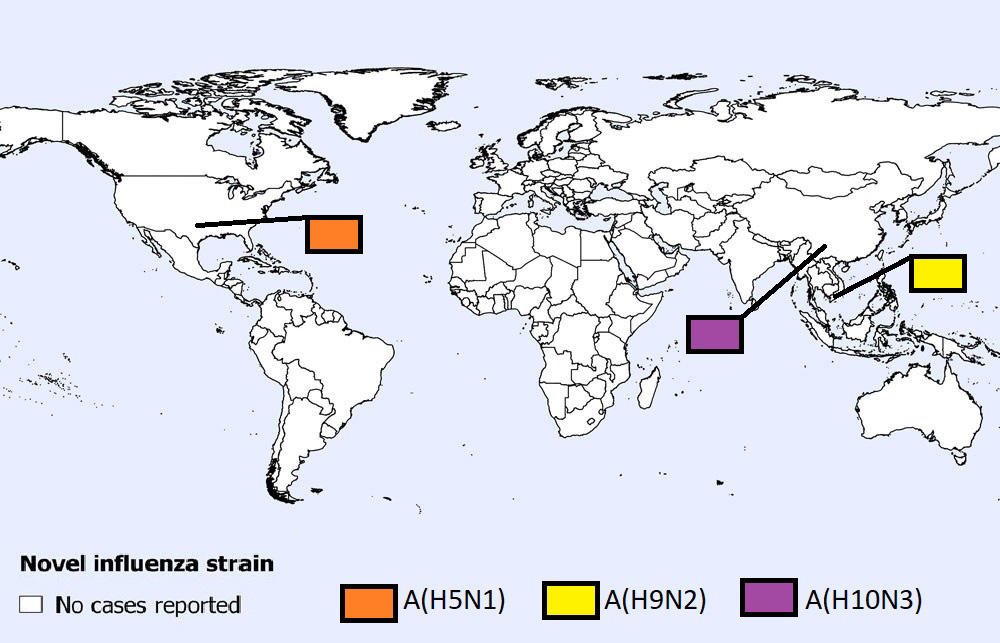
Figure 1 : Descriptive text
One (1) A(H5N1) case was reported in the United States.
One (1) A(H9N2) case was reported in Vietnam.
One (1) A(H10N3) case was reported in China.
Note: Map was prepared by CERIPP using data from the latest WHO Event Information Site (EIS) postings. This map reflects data available through these publications as of April 30, 2024.
Avian influenza updates
Avian influenza A(H5N1)
One new human case of avian influenza A(H5N1) was reported in April 2024 from the United States.
The case was a male >18-years-old from Texas. He developed conjunctivitis on March 27, 2024. The case was treated with oseltamivir and was in isolation while recovering. The case did not report any symptoms other than conjunctivitis. He was not hospitalized and has recovered. The case worked at a dairy cattle farm and had exposure to dairy cattle infected with avian influenza A(H5N1). No secondary cases have been identified. Avian influenza A(H5N1) virus has been recently detected in dairy cattle and wild birds in Texas. According to the WHO, this case appears to be the first human infection with A(H5N1) acquired from contact with an infected mammal, although human infections with other influenza subtypes have previously been acquired from mammals.
In 2024, seven human cases of avian influenza A(H5N1) have been detected worldwide, mostly from Cambodia (5/7). Since 2022, 26 human cases of A(H5N1) have been reported worldwide (2022: n=6, 2023: n=13, 2024: n=7) in Cambodia (11), Chile (1), China (2), Ecuador (1), Spain (2), United Kingdom (5), United States (2), and Vietnam (2) (Figure 2). Of these cases, 13 of the viruses belong to the same strain of A(H5N1) that is associated with the current global outbreak in animals (clade 2.3.4.4b), 1 is tentatively from this same strain, 10 cases were infected with viruses that belonged to a different strain of A(H5N1) (clade 2.3.2.1c). The clade details of two cases from Cambodia are unknown. The A(H5N1) clade 2.3.2.1c detected in Cambodia is different from the clade A(H5N1) 2.3.4.4b that is predominantly circulating worldwide, including in Canada.
Since the emergence of A(H5N1) in humans in 1997, 907 human cases of A(H5N1) have been reported globally, with a CFR of 52% (Figure 3). In Canada, A(H5N1) detections associated with the current 2021-2024 A(H5N1) clade 2.3.4.4b epizootic have been reported in domestic, backyard, and wild bird populations, as well as other animal species. No domestically acquired human A(H5N1) infections have ever been reported in Canada; however, in 2014, Canada (Alberta) reported a single fatal case of A(H5N1) in a resident returning from travel in China.
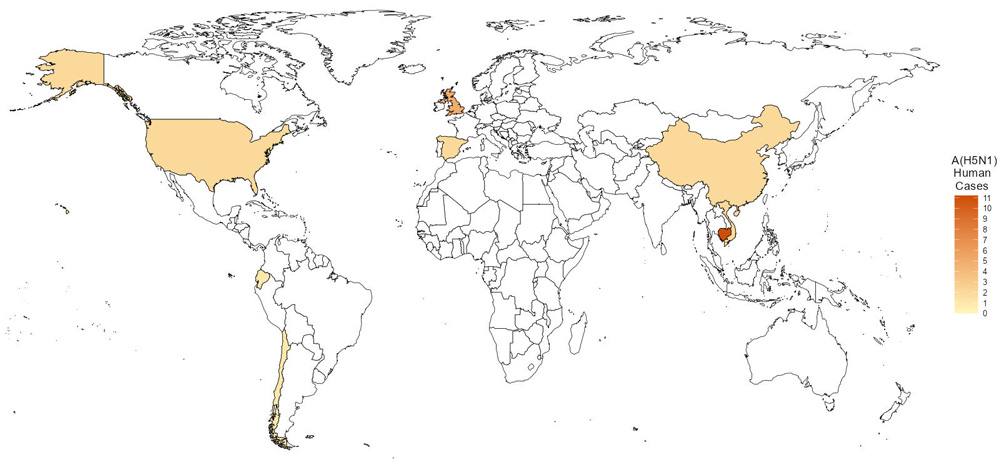
Figure 2 : Descriptive text
Eleven (11) cases were reported out of Cambodia.
Five (5) cases were reported out of the United Kingdom.
Two (2) cases were reported out of China.
Two (2) cases were reported out of Spain.
One (1) case was reported out of Chile.
One (1) case was reported out of Ecuador.
Two (2) cases were reported out of the United States of America.
Two (2) cases were reported out of Vietnam.
Note: Map was prepared by CERIPP using data from the WHO EIS postings, the US CDC's Health Alert Network (HAN), and WHO cumulative case counts. This map reflects data available as of April 30, 2024.
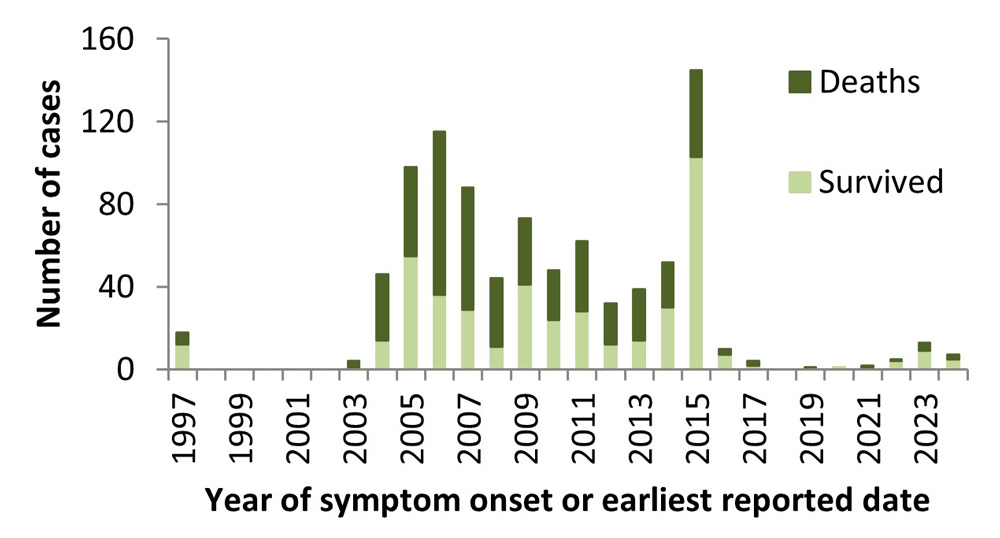
Figure 3 : Descriptive text
| Year | Number of Cases | Deaths | Survived |
|---|---|---|---|
| 1997 | 18 | 6 | 12 |
| 1998 | 0 | 0 | 0 |
| 1999 | 0 | 0 | 0 |
| 2000 | 0 | 0 | 0 |
| 2001 | 0 | 0 | 0 |
| 2002 | 0 | 0 | 0 |
| 2003 | 4 | 4 | 0 |
| 2004 | 46 | 32 | 14 |
| 2005 | 98 | 43 | 55 |
| 2006 | 115 | 79 | 36 |
| 2007 | 88 | 59 | 29 |
| 2008 | 44 | 33 | 11 |
| 2009 | 73 | 32 | 41 |
| 2010 | 48 | 24 | 24 |
| 2011 | 62 | 34 | 28 |
| 2012 | 32 | 20 | 12 |
| 2013 | 39 | 25 | 14 |
| 2014 | 52 | 22 | 30 |
| 2015 | 145 | 42 | 103 |
| 2016 | 10 | 3 | 7 |
| 2017 | 4 | 2 | 2 |
| 2018 | 0 | 0 | 0 |
| 2019 | 1 | 1 | 0 |
| 2020 | 1 | 0 | 1 |
| 2021 | 2 | 1 | 1 |
| 2022 | 5 | 1 | 4 |
| 2023 | 13 | 4 | 9 |
| 2024 | 7 | 2 | 5 |
Note: Graph was prepared by CERIPP using data from the WHO EIS postings, the US CDC's Health Alert Network (HAN), and WHO cumulative case counts. This graph reflects data available as of April 30, 2024.
Avian influenza A(H5N6)
The most recent human case of avian influenza A(H5N6) was reported in January 2024 from China.
In 2024, one human case of avian influenza A(H5N6) was detected worldwide. In 2023, six human cases of avian influenza A(H5N6) were detected, all in China. Since January 2021, 64 cases of avian influenza A(H5N6) have been reported globally (2021: n=32, 2022: n=25, 2023: n=5, 2024: n=1) (Figure 4); the majority of cases (63) were reported from China and one case was reported from Lao PDR (Figure 4). Since the emergence of this virus in 2014, a total of 90 laboratory-confirmed human cases of avian influenza A(H5N6), including at least 35 deaths, have been reported globally (CFR: 39%). No cases have been reported in Canada.
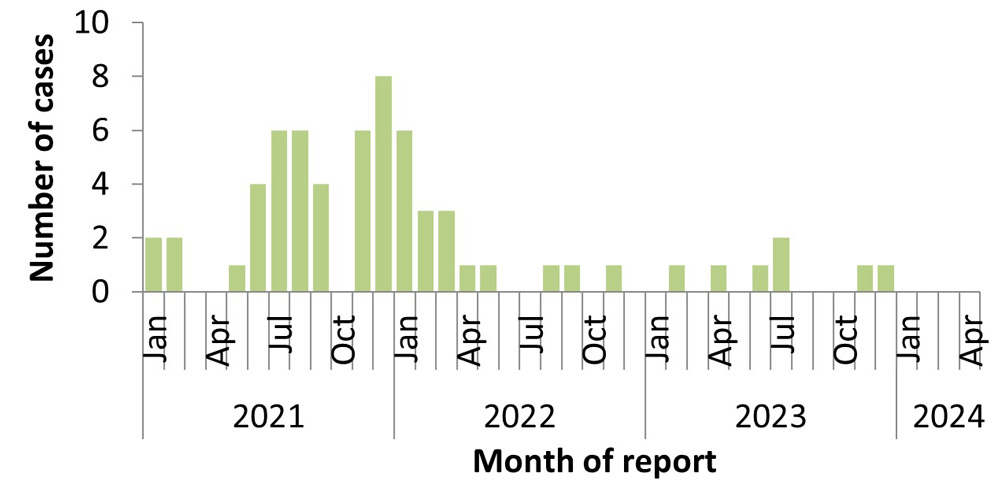
Figure 4 : Descriptive text
| Year | Month | Cases |
|---|---|---|
| 2021 | Jan | 1 |
| Feb | 2 | |
| Mar | 2 | |
| Apr | 0 | |
| May | 0 | |
| June | 1 | |
| July | 4 | |
| Aug | 6 | |
| Sep | 6 | |
| Oct | 4 | |
| Nov | 0 | |
| Dec | 6 | |
| 2022 | Jan | 8 |
| Feb | 6 | |
| Mar | 3 | |
| Apr | 3 | |
| May | 1 | |
| June | 1 | |
| July | 0 | |
| August | 0 | |
| Sep | 1 | |
| Oct | 1 | |
| Nov | 0 | |
| Dec | 1 | |
| 2023 | Jan | 0 |
| Feb | 0 | |
| Mar | 1 | |
| Apr | 0 | |
| May | 1 | |
| June | 0 | |
| July | 1 | |
| August | 2 | |
| Sep | 0 | |
| Oct | 0 | |
| Nov | 0 | |
| Dec | 1 | |
| 2024 | Jan | 1 |
| Feb | 0 | |
| Mar | 0 | |
| Apr | 0 |
Note: Graph was prepared by CERIPP using data from the WHO EIS postings and the Hong Kong Centre for Health Protection (CHP) press releases. This graph reflects data available as of April 30, 2024.
Avian influenza A(H9N2)
One new human case of avian influenza A(H9N2) was reported in April 2024 from Vietnam.
The case was a 37-year-old male from Tien Giang province, who developed a fever on March 10, 2024. He was admitted to the hospital with severe pneumonia on March 16, 2024 and transferred to the intensive care unit on March 21, 2024. He was treated with oseltamivir and antibiotics. As of the time of last report (April 12, 2024), the case was still in severe condition and receiving intensive care. The public health investigation revealed that the case's house was near a poultry market. There have been no reports of dead or sick poultry near the case's residence or reports of consumption of sick, dead or uncooked poultry products from his household or neighbouring households. One of seven samples collected from two live bird trading points within the same commune was positive for A(H5N1). A total of 15 close contacts were identified. No secondary cases have been reported.
In 2024, six human cases of avian influenza A(H9N2) have been reported worldwide, from China (5) and Vietnam (1). This case represents the first reported human infection with avian influenza A(H9N2) in Vietnam. In 2023, a total of 15 human cases of avian influenza A(H9N2) were reported globally, all in China. Since the emergence of avian influenza A(H9N2) in the human population in 1998, 127 cases have been reported worldwide, with a CFR of 2%. No cases have been reported in Canada.
Avian influenza A(H10N3)
One new human case of avian influenza A(H10N3) was reported in April 2024 in China.
The case was a 51-year-old male from Yunnan province, who developed symptoms on February 28, 2024. He was admitted to the hospital on March 6, 2024 and diagnosed with severe pneumonia. As of the time of last report (April 10, 2024), he was in critical condition. The case is a poultry and livestock farmer who was exposed to poultry and a poultry-related environment prior to illness onset. No secondary cases have been identified. Samples collected from close contacts and the environment tested negative for A(H10N3).
This is the first human case of avian influenza A(H10N3) that has been reported in 2024. Since the emergence of avian influenza A(H10N3) in humans in 2021, three human cases have been reported, all from China, with a CFR of 0%. However, with only three human cases reported to date, the full spectrum of disease is highly uncertain. No cases have been reported in Canada.
Swine influenza updates
Swine origin influenza A(H1N1)v
The most recent human cases of swine origin influenza A(H1N1)v were reported in February 2024 from Brazil (1) and Spain (1).
In 2024, 2 human cases of swine origin influenza A(H1N1)v have been detected worldwide. There have been 5 human A(H1N1)v cases reported worldwide in 2023 in Brazil (1), China (2), Spain (1) and Switzerland (1). A total of 48 human cases of A(H1N1)v have been reported globally since 2005, with a 2% CFR. Two A(H1N1)v detections have been reported in Canadian residents since reporting began in 2005, with the first case reported in Ontario in September 2012 and the second case reported in Manitoba in April 2021 (see HERP Bulletin no 52).
Swine origin influenza A(H1N2)v
The most recent human case of swine origin influenza A(H1N2)v was reported in March 2024 from the United States.
In 2024, one human case of swine origin influenza A(H1N2)v was detected worldwide. In 2023, 4 human swine origin influenza A(H1N2)v cases were reported worldwide in Taiwan (1), the UK (1), and the United States (2). A total of 52 human cases of swine origin influenza A(H1N2)v have been reported globally since 2005, with a 0% CFR. Three swine origin influenza A(H1N2)v detections have been reported in Canadian residents since reporting began in 2005. The first case was reported in Alberta in October 2020 (see HERP Bulletin no 46), the second case was reported in Manitoba in April 2021 (see HERP Bulletin no 52) and the latest case in Canada was reported in November 2021 in Manitoba (see HERP Bulletin no 59).
Swine origin influenza A(H3N2/H3NX)v
The most recent human case of swine origin influenza A(H3N2)v was reported in November 2022 from the United States. The most recent human case of swine origin influenza A(H3NX)v was reported in August 2023 from the United States.
To date, no human cases of swine origin influenza A(H3N2)v have been reported worldwide in 2024. Excluding the reported case of A(H3NX)v in the United States (1), no cases of swine origin influenza A(H3N2)v were detected in 2023. Globally, 446 swine origin influenza A(H3N2)v cases have been reported since 2005, with <1% CFR. Two swine origin influenza A(H3N2)v detections have been reported in Canadian residents since reporting began in 2005, with the latest case reported in June 2021 (see HERP Bulletin no 54).
Middle East respiratory syndrome coronavirus (MERS-CoV) update
The most recent human case of MERS-CoV was reported in February 2024 from Saudi Arabia.
To date, one new human case of MERS-CoV and one new fatality has been reported in 2024. In 2023, 10 cases of MERS-CoV were reported in Oman (1), Saudi Arabia (8), and the United Arab Emirates (1). According to the WHO, 2,610 laboratory-confirmed cases of MERS-CoV, including 940 deaths, have been reported globally since reporting began in 2012 (CFR: 36%) (Figure 5). No cases have ever been reported in Canada.
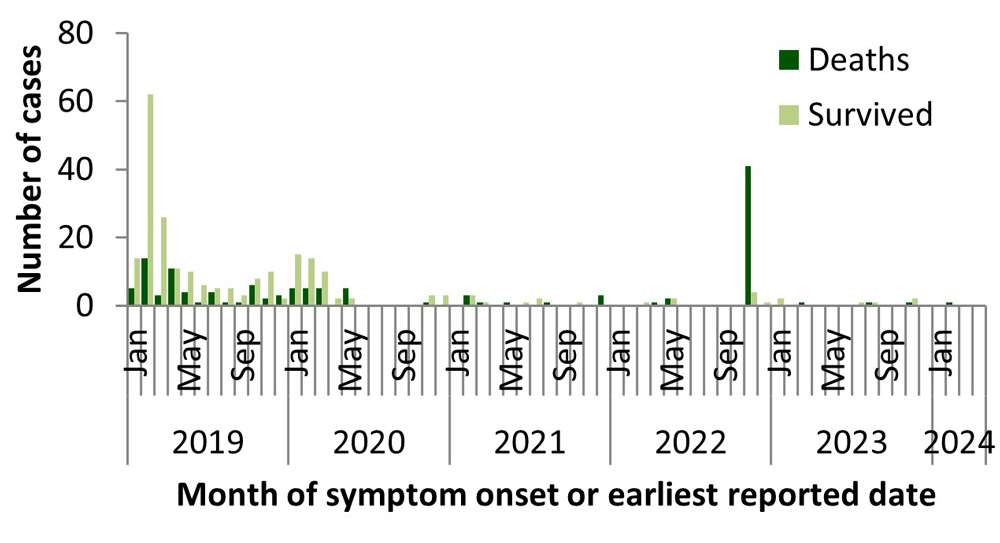
Figure 5 : Descriptive text
| Year | Month | Deaths | Survived |
|---|---|---|---|
| 2019 | Jan | 5 | 14 |
| Feb | 14 | 62 | |
| Mar | 3 | 26 | |
| Apr | 11 | 11 | |
| May | 4 | 10 | |
| June | 1 | 6 | |
| July | 4 | 5 | |
| Aug | 1 | 5 | |
| Sep | 1 | 3 | |
| Oct | 6 | 8 | |
| Nov | 2 | 10 | |
| Dec | 3 | 2 | |
| 2020 | Jan | 5 | 15 |
| Feb | 5 | 14 | |
| Mar | 5 | 10 | |
| Apr | 0 | 2 | |
| May | 5 | 2 | |
| June | 0 | 0 | |
| July | 0 | 0 | |
| Aug | 0 | 0 | |
| Sep | 0 | 0 | |
| Oct | 0 | 0 | |
| Nov | 1 | 3 | |
| Dec | 0 | 3 | |
| 2021 | Jan | 0 | 0 |
| Feb | 3 | 3 | |
| Mar | 1 | 1 | |
| Apr | 0 | 0 | |
| May | 1 | 0 | |
| June | 0 | 1 | |
| July | 0 | 2 | |
| Aug | 1 | 0 | |
| Sep | 0 | 0 | |
| Oct | 0 | 1 | |
| Nov | 0 | 0 | |
| Dec | 3 | 0 | |
| 2022 | Jan | 0 | 0 |
| Feb | 0 | 0 | |
| Mar | 0 | 1 | |
| Apr | 1 | 0 | |
| May | 2 | 2 | |
| June | 0 | 0 | |
| July | 0 | 0 | |
| August | 0 | 0 | |
| Sep | 0 | 0 | |
| Oct | 0 | 0 | |
| Nov | 41 | 4 | |
| Dec | 0 | 1 | |
| 2023 | Jan | 0 | 2 |
| Feb | 0 | 0 | |
| Mar | 1 | 1 | |
| Apr | 0 | 0 | |
| May | 0 | 0 | |
| June | 0 | 0 | |
| July | 0 | 1 | |
| August | 2 | 1 | |
| Sep | 0 | 0 | |
| Oct | 0 | 0 | |
| Nov | 1 | 2 | |
| Dec | 0 | 0 | |
| 2024 | Jan | 0 | 0 |
| Feb | 1 | 0 | |
| Mar | 0 | 0 | |
| Apr | 0 | 0 |
Note: Graph was prepared by CERIPP using data from the WHO Disease Outbreak News (DON) and Saudi Arabia's Ministry of Health. This graph reflects data available as of April 30, 2024. The data integrates CERIPP real-time reporting with WHO DON retrospective reporting of MERS-CoV cases and deaths. In November 2022, the WHO published a DON article that updated their counts with retrospective cases and deaths, which resulted in an increase of an additional 5 cases and 41 deaths compared to their previous MERS-CoV-related DON. In August 2023, the WHO published a DON article with case information for three retrospective MERS-CoV cases and two deaths. These three cases and one death were already reflected in the cumulative case count of the DON article published in July 2023, as well as the case totals published in HERP Bulletin no 79.
